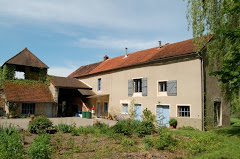The whole of Saturday 5 December was dedicated to the Téléthon, in the papers, on TV and in the streets of every self-respecting village and town in France. We have finally found out what the Téléthon is all about; it is a yearly nationwide fundraising event for a research institute for myopathy. Something like this on a yearly basis is unknown in the Netherlands, but maybe it is comparable with Red Nose Day in the UK. Each year another (mostly) French celebrity is godfather of the Téléthon, such as Alain Delon, Mireille Matthieu, Julien Clerc and this year the famous actor Daniel Auteuil (Jean de Florette / Manon des Sources).

We also found out why this event is so important in Cormatin; one of the village children is suffering from myopathy, and with only 500 inhabitants almost everybody knows kid and parents personally.
We did not have time (and had no intention!) to sit and watch TV all day. After we had helped putting up the tents in front of the church in Cormatin, carried and put up long wooden tables, emptied car boots and carried boxes from car to tent, the Téléthon in Cormatin slowly got going after 10 o’clock. One tent was hosting second hand books, DVD’s and videos, another stall was selling mulled wine, snacks, wafers, ready made boxes with petit salé aux lentils (a typical winter dish from the North of France), in another women were making and selling Christmas decorations, and in yet another one they were selling roses. Throughout the day some children were playing guitar and accordeon, a local bicycle club had organised a tour around all Téléthons in the vicinity, buying something in every village, like a sandwich, some wafers, a glass of mulled wine....

Slowly it started to dawn why we had been making paper roses the week before. On the steps in front of the war memorial a huge board was mounted, with in it cut out the Téléthon logo. For each sold real rose (à € 1 a piece) a paper rose was stuck in the openings of the wooden board, thus producing a multicoloured Téléthon logo by the end of the day! Half the population was in the mean time trying to make the event a success, and the other half was supposed to hang around, buy roses or a second hand book, or spend money in any other way, thus enabling the organiser Monsieur P. to phone the central fund raising authorities to proudly announce that Cormatin had managed to clock up another € 4000 (roughly the average over the past years). This was not the first time that I had noticed that some Cormatinoises are very good in selling package deals.

After we had helped putting up the tents we went off to buy the Saturday edition of Le Monde at the local Tabac. However, Mme B. did not let us leave with just Le Monde; we were more or less forced to buy two boxes of petit salé aux lentils. She was very persuasive, with arguments as “I have bought them myself as well”, it makes an excellent and easy luch, and it is for a good cause. Finally we did not leave the shop before we had dished out € 11 in return for two slips of paper entitling us to two boxes. We walked back to the stand with the snacks and in exchange for our pieces of paper we obtained the food, consisting of a layer of lentils garnished with various pieces of meat, such as streaky bacon, sausage and pork. How much the final result for Cormatin is going to be is still unknown; however, Mme B. did not exaggerate about the food; we absolutely do not mind to support next year’s Téléthon exactly the same way!
The website of La Tuilerie de Chazelle








